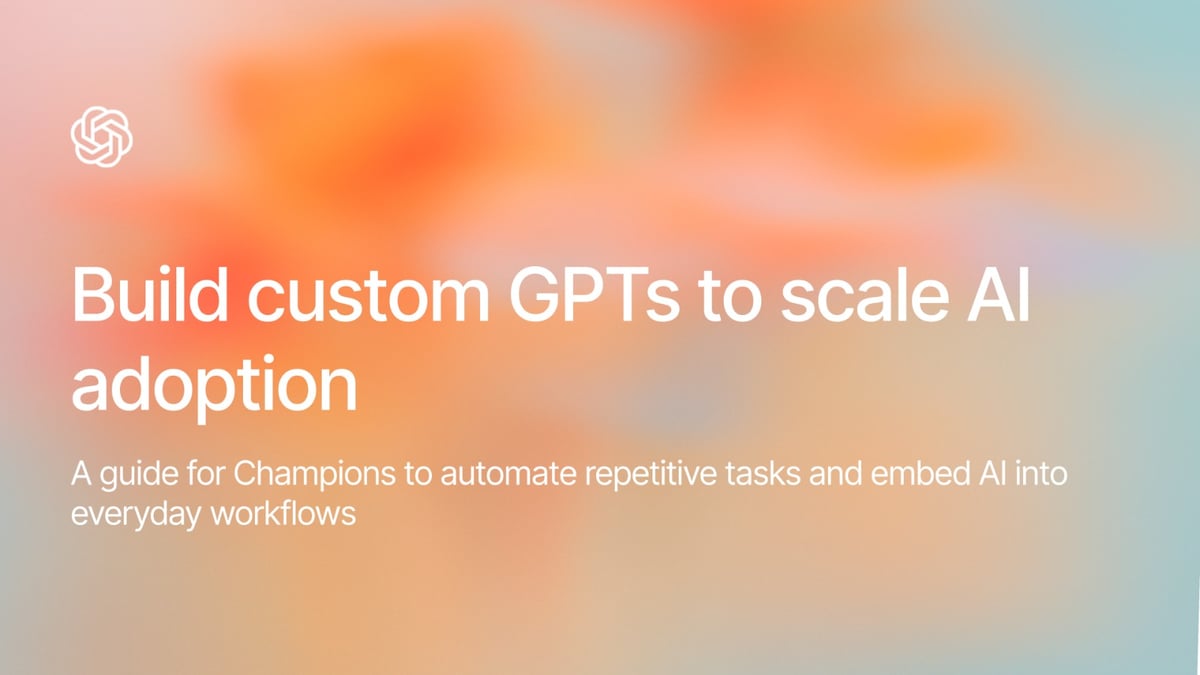Article
August 5, 2025 · Last updated on August 7, 2025
Building custom GPTs to scale AI adoption

# Champions
# Custom GPTs
# Driving Adoption
A guide for Champions to automate repetitive tasks and embed AI into every workflows

Build custom GPTs to scale AI adoption
The strongest AI adoption programs don’t stop at collecting prompts, they turn what’s working into durable, repeatable tools. Custom GPTs are that next layer. They can reduce prompting friction, standardize proven approaches, and make AI more accessible to every member of a team.
In high-performing teams, the clearest sign of GPT value is repeat use. Teams keep coming back to GPTs not because they’re novel, but because they make real tasks faster, more consistent, and easier to start.
Champions are uniquely positioned to drive this shift. By translating lessons from prompt challenges into GPTs, selecting the right opportunities, and showing exactly how these tools help, Champions can embed GPTs into daily workflows and make adoption stick.
This guide shows you how: from identifying custom GPT opportunities to building them from proven prompts and using them to take AI adoption from early wins to enterprise scale.
1. From prompt challenges to custom GPTs
Prompt challenges are a powerful way to uncover what’s working, the prompts people actually use, the workflows they return to, and the patterns that deliver clear value.
Building custom GPTs is the natural next step. A well-designed GPT turns a proven prompt into a durable tool that:
- Makes a repeatable prompt accessible to everyone, without copy-pasting or guesswork
- Standardizes output for recurring tasks, so reviews and edits take less time
- Encourages hesitant users to get started because they don’t have to know how to write the perfect prompt
When Champions move from prompt curation to GPT creation, they extend their influence from finding what works to scaling what works, turning individual wins into team-wide, repeatable success.
2. Where Champions add value
You don’t need to build a large custom GPT library to make a difference. One well-chosen custom GPT, designed for a high-leverage workflow, can change how a team works.
The Champions driving the most adoption focus on a few key habits:
- Spotting repeatable friction: They notice when teammates are re-writing the same content, re-summarizing notes, or starting from scratch on recurring deliverables.
- Building simple, task-specific GPTs: Each GPT does one job well, is quick to test, and easy for others to trust.
- Making GPTs visible in context: They introduce a GPT at the exact moment someone is about to start the task it solves, not as an abstract tool in a resource list.
- Enabling others to build: Over time, they guide neighboring teams through the build process, turning early wins into a wider organizational capability.
Champions who work this way extend their impact far beyond their own team, creating both the tools and the skills that help AI adoption grow across the organization.
3. Selecting GPT opportunities
Not every prompt should become a GPT. The strongest candidates tend to share three characteristics:
- Repeatability: The task appears regularly (weekly updates, client recaps, quarterly reviews)
- Proven success: A prompt from your challenge has been reused and praised for clarity, time savings, or quality
- Low variance: The output structure is predictable like bullet points, summaries, or standardized reports
Signals to look for after a Prompt Challenge:
- The same prompt (or a close variant) appears in multiple submissions.
- A prompt is being shared informally across Slack threads, documents, or wikis.
- Teams report significant reductions in drafting or editing time when they use it.
When you see these patterns, you’re not guessing, you’re building GPTs from prompts that are already embedded in how people work, increasing the odds they’ll be adopted quickly.
4. What makes a GPT useful
The most effective GPTs are designed for adoption, not complexity. They solve a single problem well and make it easier for people to start and finish their work.
A useful GPT typically has:
- A single, clear purpose. ex: “Turn meeting notes into a 3-bullet leadership summary.”
- Structured inputs. Clear guidance on what to paste or include.
- Consistent outputs. A defined format that reduces editing time.
- Audience awareness. Built-in cues for tone, style, or emphasis.
- Guardrails. Reminders to verify sensitive data and review outputs.
- A feedback loop. A quick way for users to suggest improvements.
Trying to solve multiple, unrelated problems in one GPT usually results in inconsistent outputs and low trust. Focus on one workflow at a time, that’s how you build tools people return to and recommend.
5. Build, test, and refine
Creating a custom GPT doesn’t require technical expertise, if you can write a clear prompt, you can build one. Check out the Building GPTs collection on the OpenAI Help Center to get started.
A simple loop is enough:
- Start with a strong prompt from your challenge results
- Add structure: clarify inputs, audience, and output format
- Test with real examples from different teammates, note where instructions need to tighten
- Refine based on feedback, not assumptions
- Release with context: explain the task it solves and when to use it
You’re not aiming for perfection. You’re aiming for a starting point that’s 70–80% of the way there so your team can spend their time editing and improving, not drafting from scratch.
If you want to extend your GPT’s capabilities, you can explore GPT Actions (if enabled by your workspace admin) which are an advanced feature that connects GPTs to other tools and data sources. Actions require some technical setup and aren’t necessary for most adoption-focused GPTs, but they can unlock powerful automations once your team is ready. Learn more in the OpenAI GPT Actions documentation.
6. Drive GPT usage
A GPT is only useful if people use it. Here are some examples on how Champions make this happen:
- Demoing the GPT live and showing the input → output → results
- Dropping the GPT link in context by replying to a planning thread with, “We built this GPT for leadership updates, paste your notes and it will format them into bullets.”
- Embedding GPTs in templates and linking them directly from recurring docs or wikis.
- Including GPTs in onboarding and making them part of the standard toolkit for new team members.
GPTs often see stronger adoption when they’re made part of familiar workflows and their value is reinforced through everyday interactions.
7. Measuring GPT impact
The goal isn’t heavy analytics. It’s understanding where GPTs make work faster, clearer, or more consistent. Champions often look for:
- Usage lift: an increase in ChatGPT activity after GPT rollout
- Time saved: self-reported reductions in draft or editing time
- References in meetings or updates: teammates calling out, “I used the summary GPT for this doc”
- Feedback loops: quick comments like “This output saved me 20 minutes”
Share these signals with your team and leaders to reinforce the value of GPTs. Even a small, consistent impact — like a 20–30 minute saving on a weekly task — can scale significantly when multiplied across people and projects.
8. Scaling GPT influence
Champions who drive the most adoption follow a steady progression that expands both their impact and the organization’s AI capability:
- Build for your own team: Start with one or two GPTs that solve high-value, repeatable workflows.
- Share with adjacent teams: Offer GPTs where workflows overlap, such as summaries, QBR prep, or standard reports.
- Mentor others to build: Show another team how to turn their own prompts into GPTs, using your process and lessons learned.
- Standardize and update: Curate a small, active library of GPTs that reflects real usage and retire those that are no longer relevant.
Following this path takes you from creating tools for your own team to becoming a peer mentor — someone who not only builds GPTs but also helps others do the same. This shift is what grows adoption across departments and turns early wins into organization-wide capability.
9. Connecting back to prompt challenges
Prompt Challenges aren’t just a fun way to spark ideas — they’re the foundation for building GPTs that matter.
The prompts surfaced during a challenge provide:
- Content for GPT instructions – Prompts that deliver real value can be adapted directly into GPT workflows.
- Recurring workflows – Frequent patterns in challenge submissions point to strong GPT candidates.
- Engaged contributors – Participants from the challenge can become your first co-testers and advocates.
A GPT built from this foundation isn’t abstract — it’s grounded in how your team already works, trusted because it reflects their own input, and easier to adopt because it solves a need they’ve already expressed.
By pairing Prompt Challenges with custom GPT creation, Champions create a cycle: generate ideas → build tools → scale adoption.
Final thought
GPTs are one of the most effective ways to embed AI into team workflows because they make success repeatable. Champions don’t need to build many they need to build the right ones, share them at the right time, and help others do the same.
Start small: choose one proven prompt, turn it into a GPT, and show its value in the flow of work. From there, teach others how to build their own. This is how adoption moves from interest to habit and how AI becomes a natural, trusted part of how your organization works every day.
Table Of Contents
Popular
Resource
The AI Champion role
Resource
Use Case Showcase Playbook

